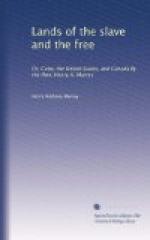Through the kindness of Mr. B. Seaver, the Mayor of Boston, I was enabled to visit several of these schools, the cleanliness of which, as well as their good ventilation, was most satisfactory. The plan adopted here, of having the stools made of iron and screwed on to the floor, with a wooden seat fixed on the top for each pupil, and a separate desk for every two, struck me as admirably calculated to improve ventilation and check sky-larking and noise. The number of public schools in the whole State is 4056, which are open for seven months and a half in the year, and the average attendance of scholars is 145,000; besides which, there are 749 private schools, with 16,000 scholars. It is a curious fact, and bears strong testimony to the efficiency of the public schools, that while they have increased by 69 during the year, the private schools have decreased by 36. The foregoing sketch is from the official Reports, printed at Boston in 1853.
In addition to these schools, there are four colleges, three theological seminaries, and two medical schools. Of these I shall only notice one of the colleges, which I visited, and which enjoys a high reputation—viz., Harvard College, or Cambridge, as it is sometimes called, from the village where it is situated. The history of this college is a wholesome proof how a small institution, if duly fostered by a nation, may eventually repay future generations with liberal interest. Established in 1636, by a vote of 400l., it obtained the name of Harvard, from the bequeathment by a reverend gentleman of that name, A.D. 1638, of the sum of 780l. and 300 volumes. Its property now amounts to upwards of 100,000l., and it is divided into five departments—collegiate, law, medical, theological, and scientific—affording education to 652 students, of whom one half are undergraduates. There are forty-five instructors, all men of unquestionable attainments, and capable of leading the students up to the highest steps of every branch of knowledge; the necessary expenses of a student are about 45l. a year; the fee for a master of arts, including the diploma, is 1l. sterling.
Meritorious students, whose circumstances require it, are allowed, at the discretion of the Faculty, to be absent for thirteen weeks, including the winter vacation, for the purpose of teaching schools. Parents who think their sons unable to take care of their own money, may send it to a patron duly appointed by the college, who will then pay all bills and keep the accounts, receiving, as compensation two and a half per cent. I think the expenses of this establishment will astonish those who have had to “pay the piper” for a smart young man at Oxford, as much as the said young man would have been astonished, had his allowance, while there, been paid into the hands of some prudent and trusty patron. Tandems and tin horns would have been rather at a discount—cum pluribus aliis.




